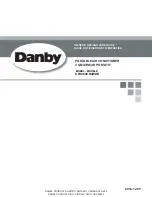
Wellea Monobloc
17
P
art
3
- Con
tr
ol
4
Normal Operation Control
4.1
Component Control during Normal Operation
Table 3-5.1: Component control during heating and domestic hot water operations
Component
Wiring diagram
label
5/7/9kW
12/14/16kW
Control functions and states
Inverter compressor
COMP
●
●
Controlled according to load requirement from
hydronic system
DC fan motor / Upper DC fan motor
FAN1 / FAN_UP
●
●
Controlled according to outdoor heat exchanger
pipe temperature
Lower DC fan motor
FAN_DOWN
●
Electronic expansion valve
EXV
●
●
Position (steps) from 0 (fully closed) to 480 (fully
open),
controlled
according
to
discharge
temperature, suction superheat and compressor
speed
Four-way valve
ST
●
●
On
Table 3-5.2: Component control during cooling operation
Component
Wiring diagram
label
5/7/9kW
12/14/16kW
Control functions and states
Inverter compressor
COMP
●
●
Controlled according to load requirement from
hydronic system
DC fan motor / Upper DC fan motor
FAN1 / FAN_UP
●
●
Controlled according to outdoor heat exchanger
pipe temperature
Lower DC fan motor
FAN_DOWN
●
Electronic expansion valve
EXV
●
●
Position (steps) from 0 (fully closed) to 480 (fully
open),
controlled
according
to
discharge
temperature, suction superheat and compressor
speed
Four-way valve
ST
●
●
Off
4.2
Compressor Output Control
The compressor rotation speed is controlled according to the load requirement. Before compressor startup,
the
Wellea
Mono outdoor unit determines the compressor target speed according to outdoor ambient
temperature,
leaving water set temperature and actual leaving water temperature and then runs the appropriate
compressor startup
program. Refer to Part 3, 4.2 “Compressor Startup Program”. Once the startup program is complete,
the compressor runs
at the target rotation speed.
During operation the compressor speed is controlled according to the rate of change in water temperature, the refrigerant
system pressure and the refrigerant temperature.
4.3
Compressor Step Control
The running speed of six-pole compressors (used on all models) in rotations per second (rps) is one third of the frequency
(in Hz) of the electrical input to the compressor motor. The frequency of the electrical input to the compressor motors can
be altered at a rate of 1Hz per second.
















































